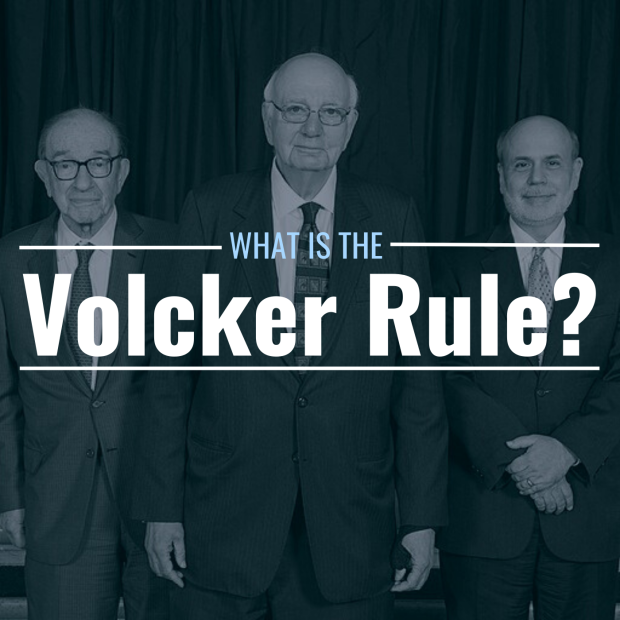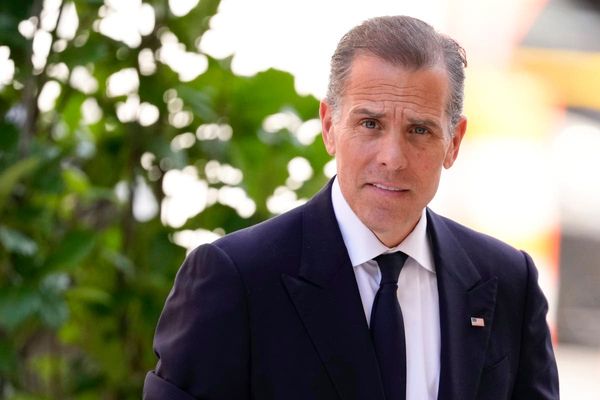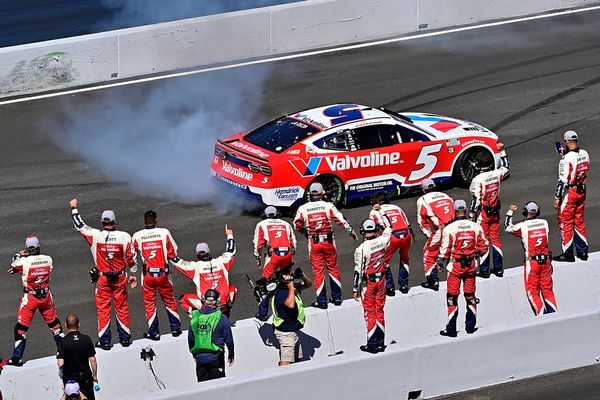
Federalreserve, Public domain, via Wikimedia Commons
What is the Volcker rule?
The Volcker rule is a provision of the Dodd-Frank Wall Street Reform and Consumer Protection Act. Passed by Congress and signed into law by President Barack Obama on July 21, 2010, Dodd-Frank enacted sweeping reforms over the financial industry in the aftermath of the Financial Crisis of 2007–2008, the worst financial crisis since the Great Depression.
Section 619 of the Dodd-Frank Act is more familiarly known as the Volcker rule. It made it illegal for banks to make speculative trades—specifically, prohibiting “proprietary trading and certain relationships with hedge funds and private equity funds.” It forbade banks from making trades that would create material conflicts of interest, or undertaking risky strategies that would create instability for its customers or the financial system as a whole.
The Volcker rule is named after Paul Volcker, who chaired the Federal Reserve from 1979 to1987 and served as the head of the Economic Advisory Board under Obama from 2009 to 2011.
In his “Commentary on the Restrictions of Propriety Trading by Insured Depositary Institutions,” Volcker explained his reasoning for advocating for Section 619—namely, that he did not believe that speculation was in the best interest of the taxpaying public.
“Losses within large trading positions were in fact a contributing factor for some of our most systemically important institutions, and proprietary trading is not an essential commercial bank service that justifies taxpayer support.”
—Paul Volcker, Commentary on the Restrictions of Propriety Trading by Insured Depositary Institutions , February 13, 2012
What factors led to the creation of the Volcker rule?
The Financial Crisis of 2007–2008, which started with an overinflated U.S. housing bubble, ballooned to global proportions due to risky trading strategies. Millions of people with little money down and less-than-perfect credit scores were sold the idea that they, too, could afford the American dream of home ownership, and so banks, like Washington Mutual, lent them money through subprime mortgages, which often contained steep, adjustable rates.
These mortgages were then securitized and traded as derivatives with investment banks like Bear Stearns—and the riskier the debt within the underlying security, the higher the payout. Insurance companies, like AIG, got into the game by selling credit default swaps as hedges—often without a single dollar in real collateral.
Fueled by seemingly endless demand, Wall Street was minting enormous profits until the bubble’s spectacular burst. By 2007, the Federal Reserve had raised interest rates four percentage points to 5.25%. Millions of subprime mortgage holders, whose loans were pegged to prevailing interest rates, were unable to pay their new, steeper monthly fees and, in turn, defaulted.
The carnage made its way through the ranks of the financial system, causing some of the world’s biggest players, like Lehman Brothers, to topple. Fearing financial contagion, Congress sent emergency assistance to both financial institutions and beleaguered homeowners—and taxpayers had to foot the bill. The stock market crashed on September 28, 2008, ushering in a two-year period of economic decline that would become known as the Great Recession.
In the aftermath of another financial crisis, the Great Depression, Congress aimed to reform the reckless speculation that had been taking place in financial institutions on both Wall Street and Main Street, which ranged from trading fraudulent securities to underwriting risky loans. The Banking Act of 1933, more commonly known as the Glass-Steagall Act, created two separate financial entities: commercial banks and investment banks. It also prohibited commercial banks from making more than 10% of their total revenue from investment securities. In other words, it separated savings from speculation and made it illegal for banks to make risky trades with their customers money.
Glass-Steagall made it illegal for banks to make risky trades with their customers' money.
During the stock market boom of the 1980s, however, commercial banks saw the profits investment banks were making and hungered for their share of the pie. Regulators started overlooking the 10% threshold, which allowed commercial banks to make bigger and bigger speculative bets.
By the 1990s, under intense pressure from banking lobbyists, Congress began chipping away at sections of Glass-Steagall that had established the “conflict of interest” between banking speculation. In November 1999, Congress passed the Gramm-Leach-Bliley Act (GLBA), which repealed two entire clauses of Glass-Steagall—Sections 20 and 32—that had separated commercial and investment banking. By doing so, they effectively allowed the formation of even larger banks, ones that would grow to be “too big to fail” and become a systemic risk—warranting even bigger taxpayer bailouts.
What did the Volcker rule do?
The Volcker rule had clear objectives: It “prohibited banks from engaging in proprietary trading or acquir[ing] or retain[ing] any equity, partnership, or other ownership interest in or sponsor[ing] a hedge fund or a private equity fund.”
It was endorsed by the five regulatory bodies that made up the Financial Stability Oversight Council:
- Commodities Futures Trading Commission
- Federal Deposit Insurance Corporation (FDIC)
- Federal Reserve
- Office of the Comptroller of the Currency
- Securities and Exchange Commission (SEC)
But how the Volcker rule would be implemented was another matter entirely.
How was the Volcker rule implemented?
The Volcker rule mandated that within six months of its passage, the Financial Stability Oversight Council must figure out how exactly to fulfill its rather vague mandates, such as “promoting and enhancing the safety and soundness of banking entities,” “protecting taxpayers by minimizing risk at insured depositary institutions,” and “reducing the conflicts of interest between banks and non-bank financial entities,” among other things.
Criticism from Wall Street was swift and sharp. Bank CEOs and other financial leaders argued that operating separate units for commercial and investment operations would tie up substantial amounts of a bank’s cash and adversely affect the market’s overall liquidity. This, in turn, would compel banks to raise their fees in terms of securities issued and commissions charged to customers. The markets, in response, would simply become less efficient, which would prompt investors to demand higher risk premiums and thus lower the value of existing assets. Loosening these restrictions, they countered, would free up billions of dollars in capital and would help the then-fragile economy recover faster.
“Only in today’s regulatory climate could such a simple idea become so complex, generating a rule whose preamble alone is 215 pages, with 381 footnotes to boot.”
—Frank Keating, Chief Executive of the American Bankers Association, October 2011
The Financial Stability Oversight Council, which invited the public for its thoughts between October 2011 and January 2012 received more than 17,000 comments.
Dodd-Frank regulations took effect on July 21, 2012, but even then-Fed-Chair Ben Bernanke admitted that the restrictions imposed in the Volcker rule would not be ready in time.
By January 2014, the five financial regulators voted to approve the measures they would undertake to implement the Volcker rule, and it took effect on July 21, 2015; however, extensions were granted on certain provisions, such as exiting investments in legacy funds, private equity, hedge funds, and illiquid investments to as far out as 2017.
Is the Volcker rule still in effect?
When Donald Trump was elected President in 2016, he had promised to “do a big number on Dodd-Frank.” He hand-selected appointees like Treasury Secretary Steve Mnuchin, who blamed the Volcker rule for increased volatility in the markets. Federal Reserve Vice Chair Randal Quarles, another Trump appointee, proposed changes to the Volcker rule, undoing the prohibition against banks investing in venture capital funds. These changes were accepted by the five financial regulators on June 25, 2020.
Other Dodd-Frank mandates were also amended: The size threshold of banks required to undergo annual stress tests from the Federal Reserve was raised from $50 billion to $250 billion.
Opponents cite these revisions as prime contributors to the banking crisis of 2023, during which three banks—Silicon Valley Bank, Signature Bank, and First Republic Bank—all failed within a six-week period, sparking new fears of yet another financial contagion. These banks were smaller, regional banks, and as such, they were no longer required to undergo annual stress tests, which shielded much of their risky behavior from the public. In addition, both Silicon Valley Bank and First Republic Bank had invested heavily in venture capital funds, such as tech IPOs.







